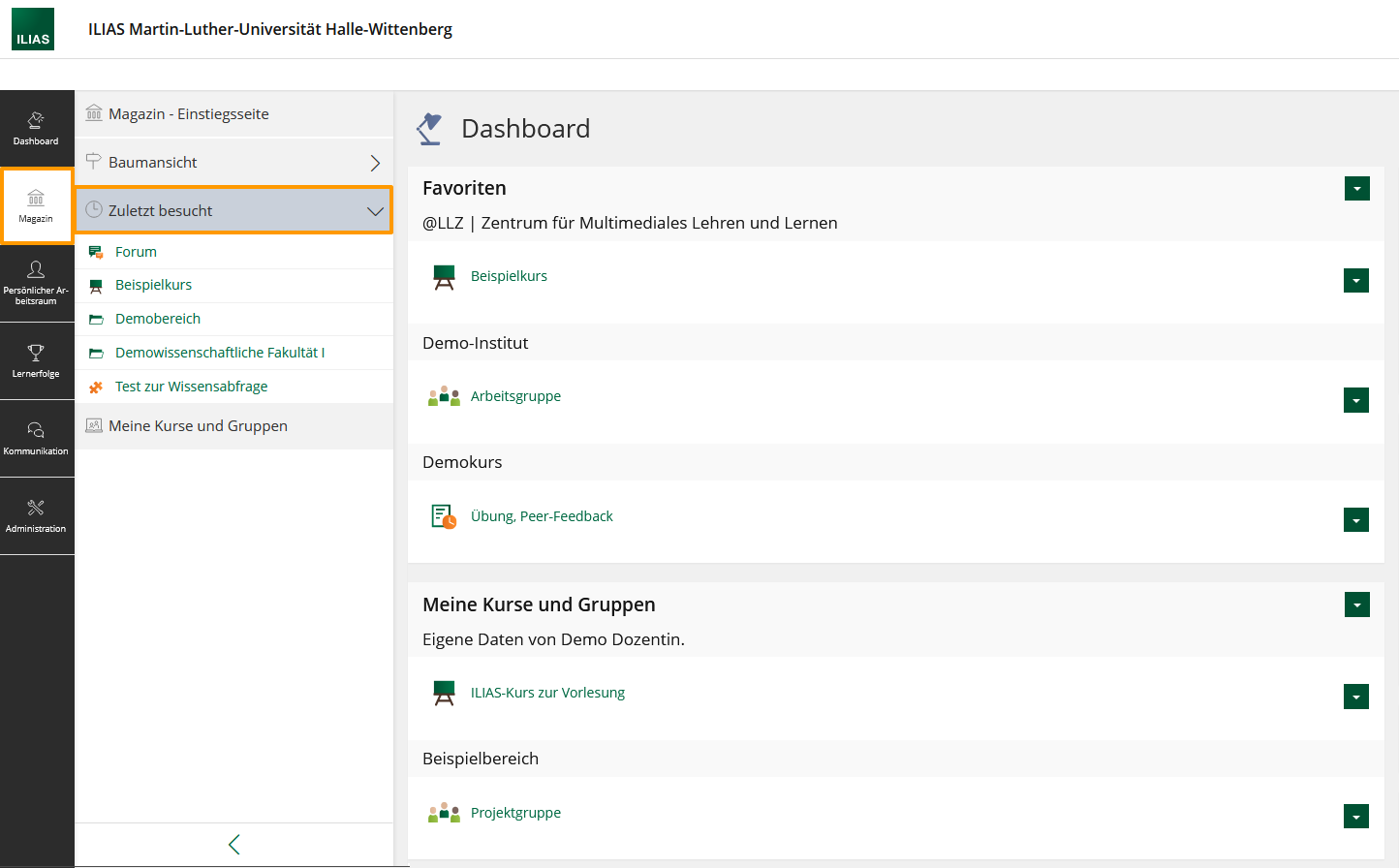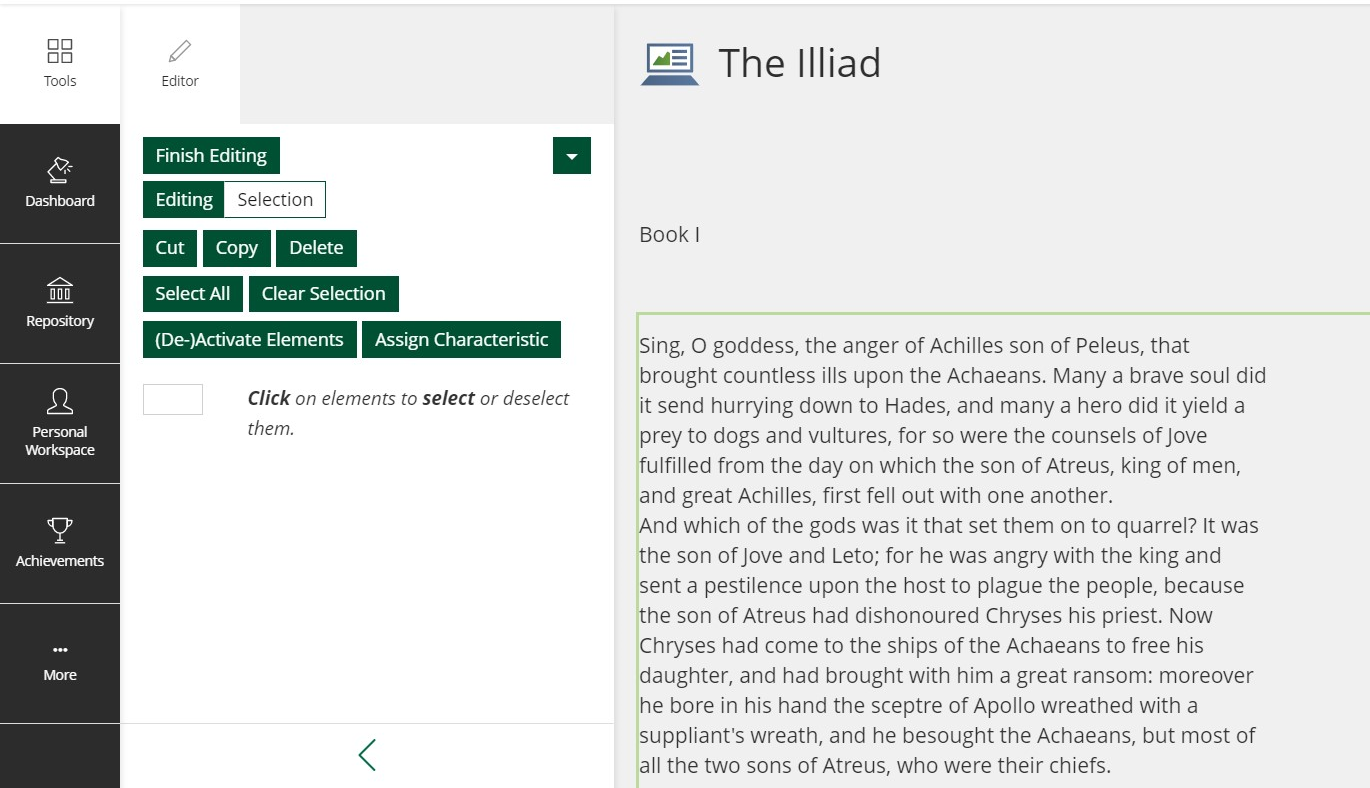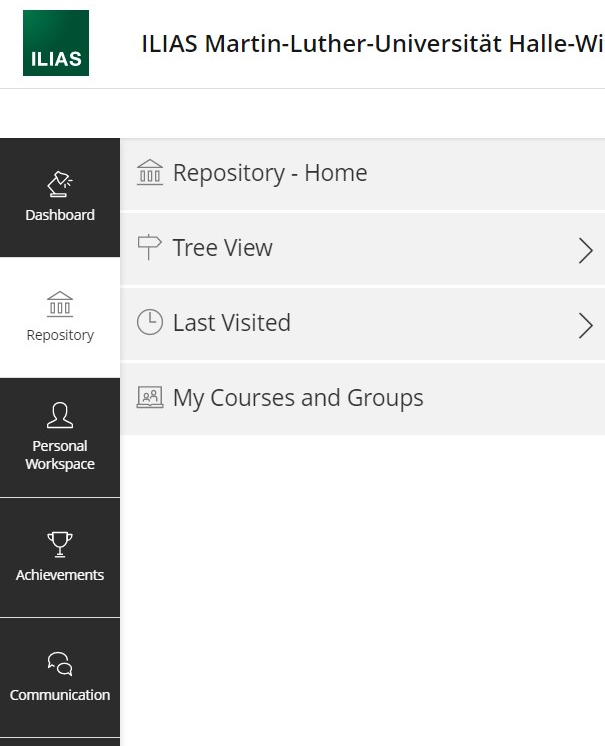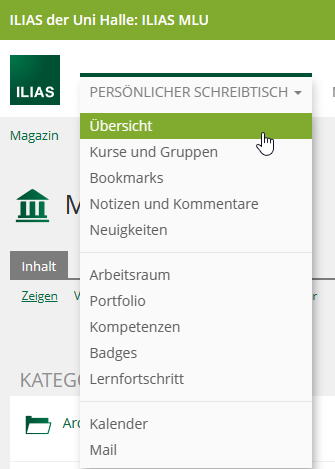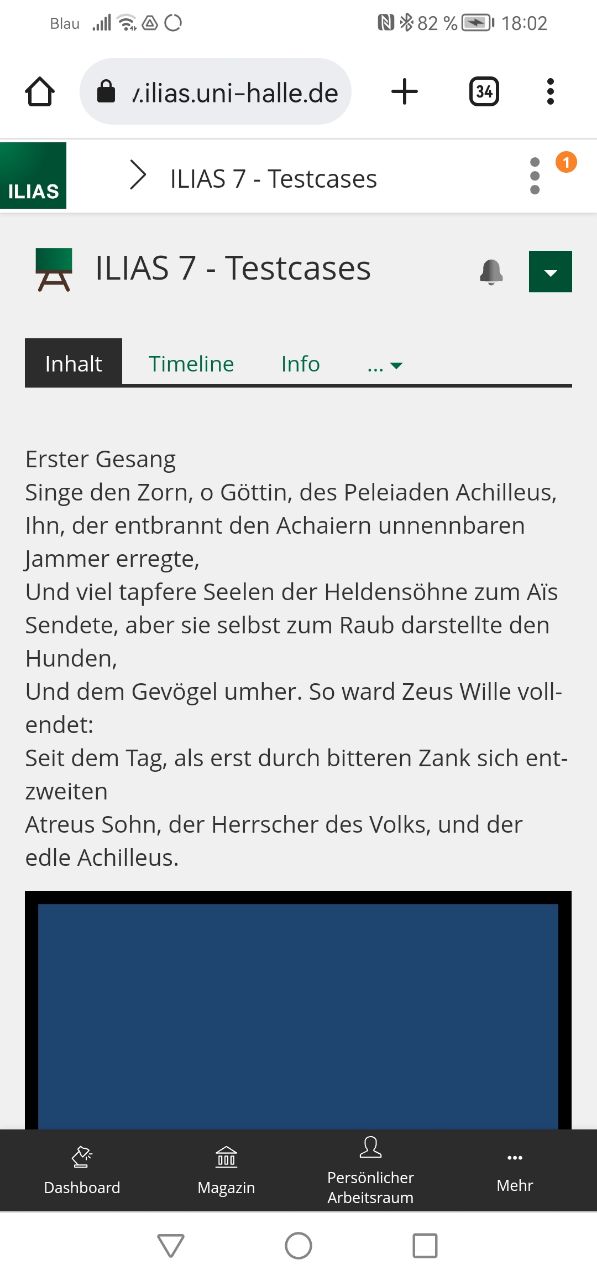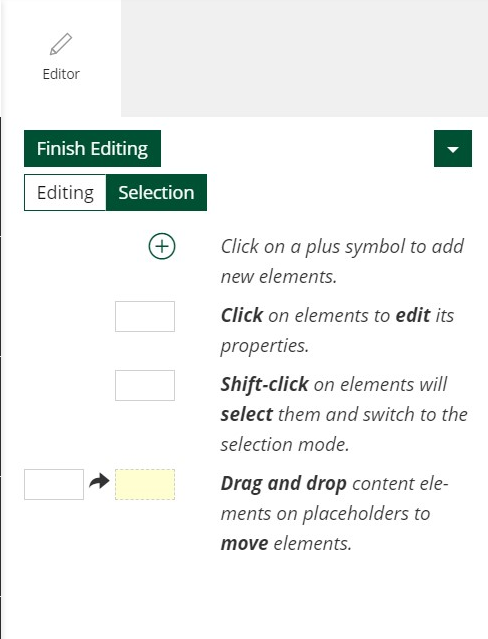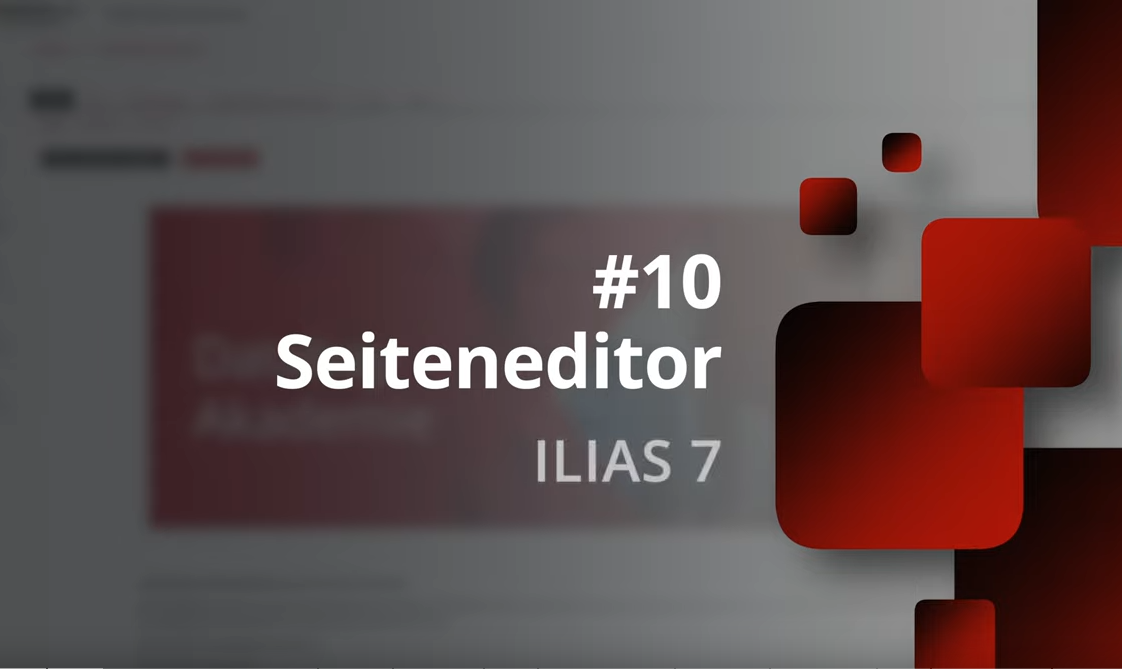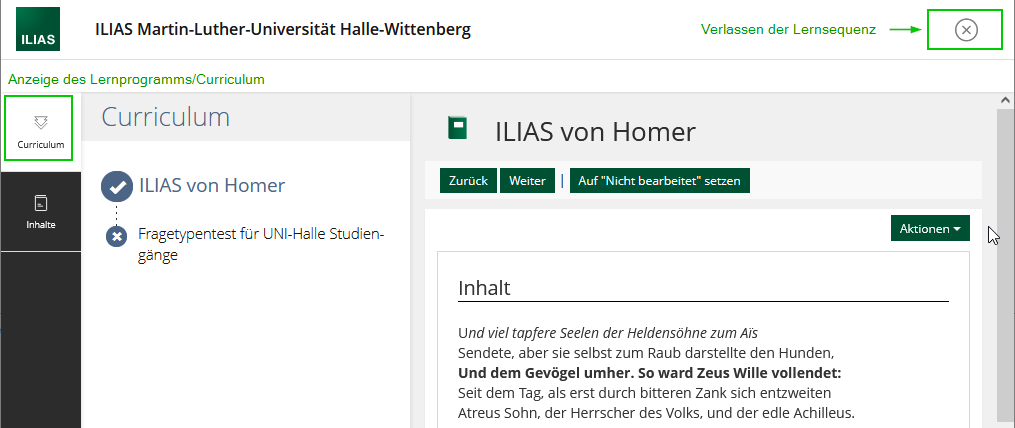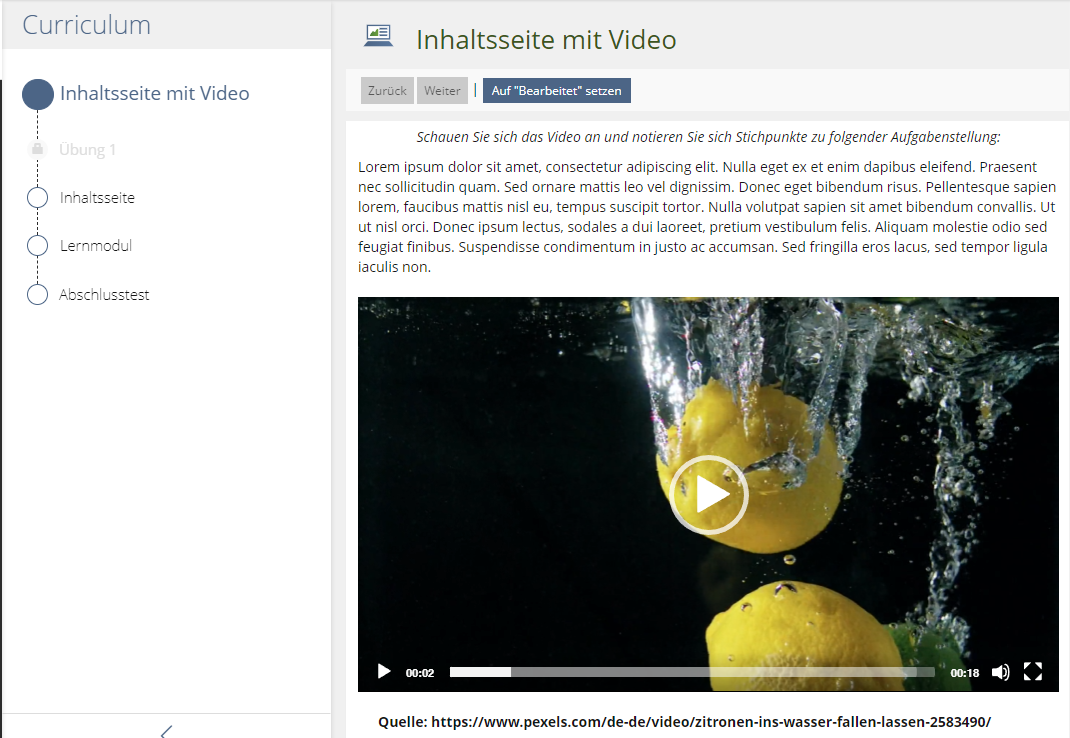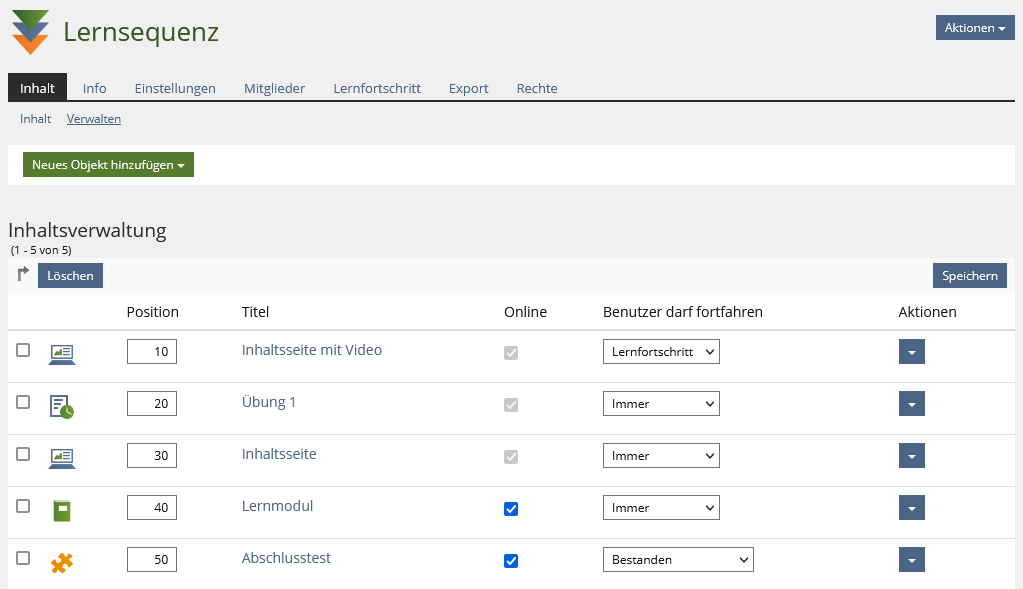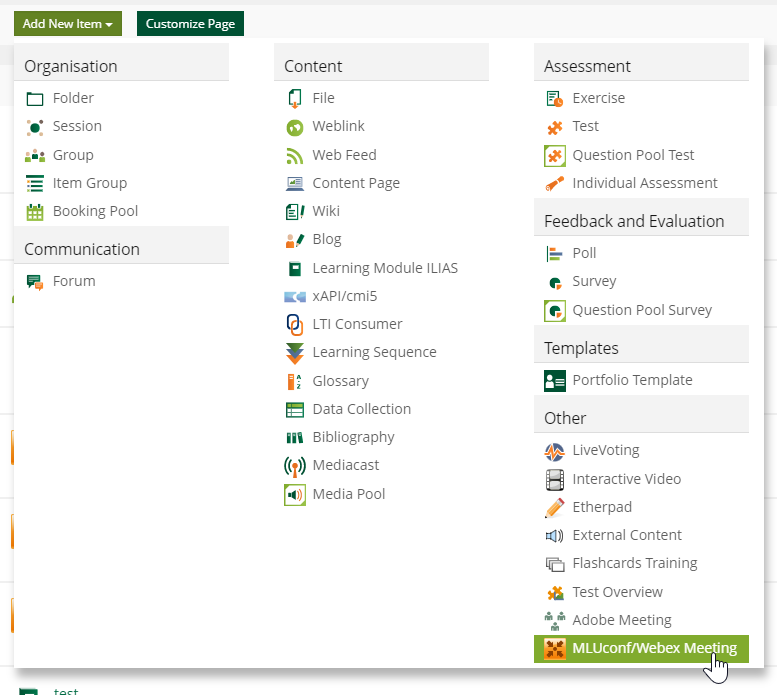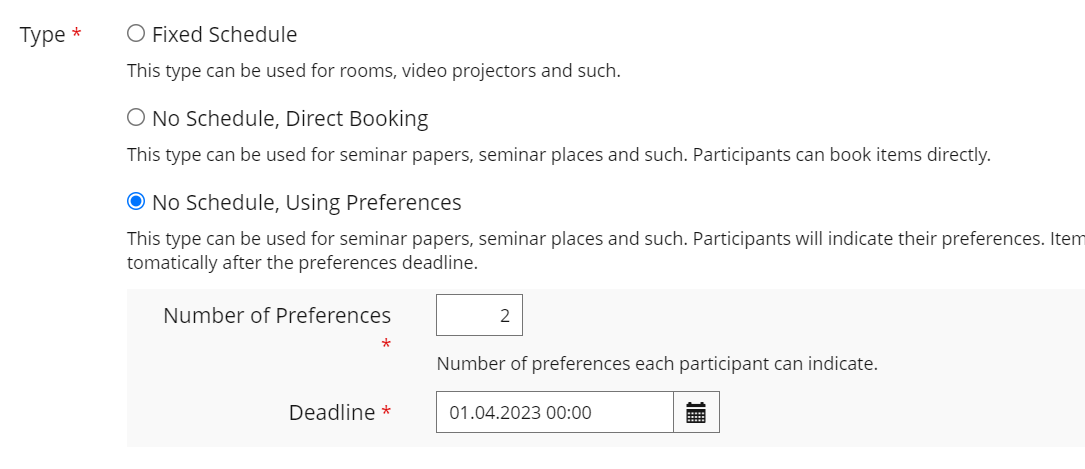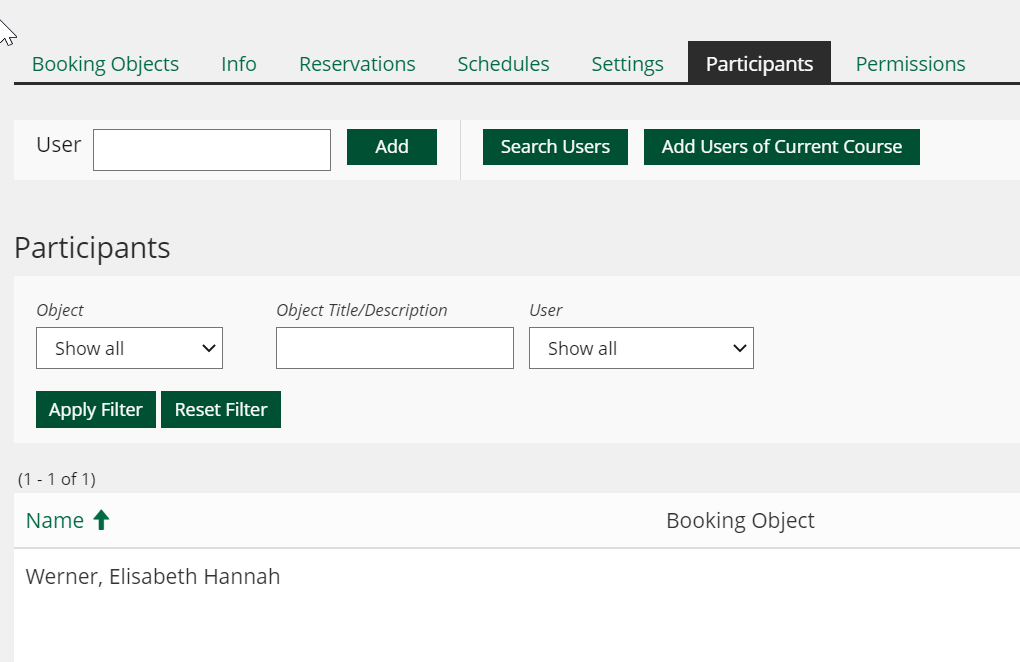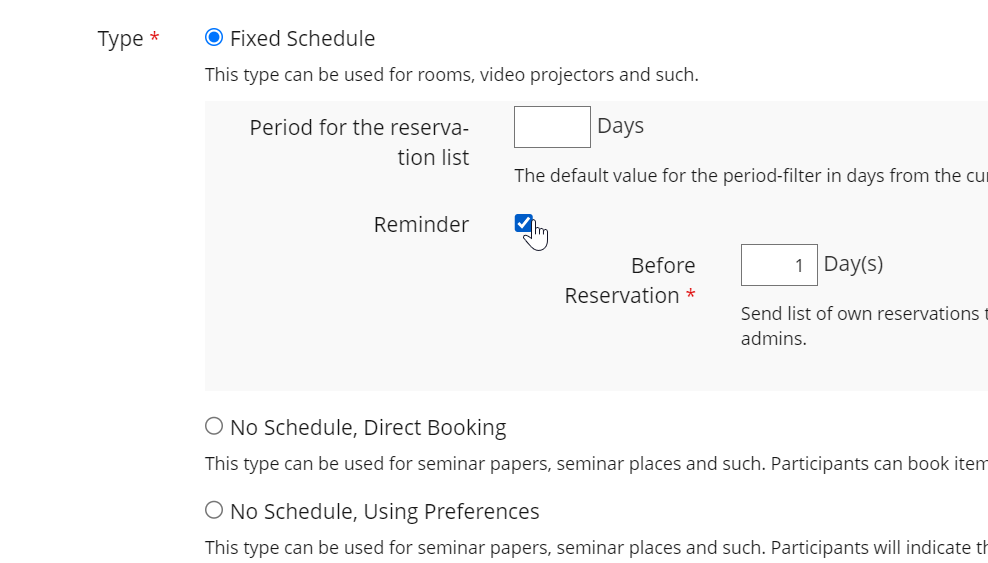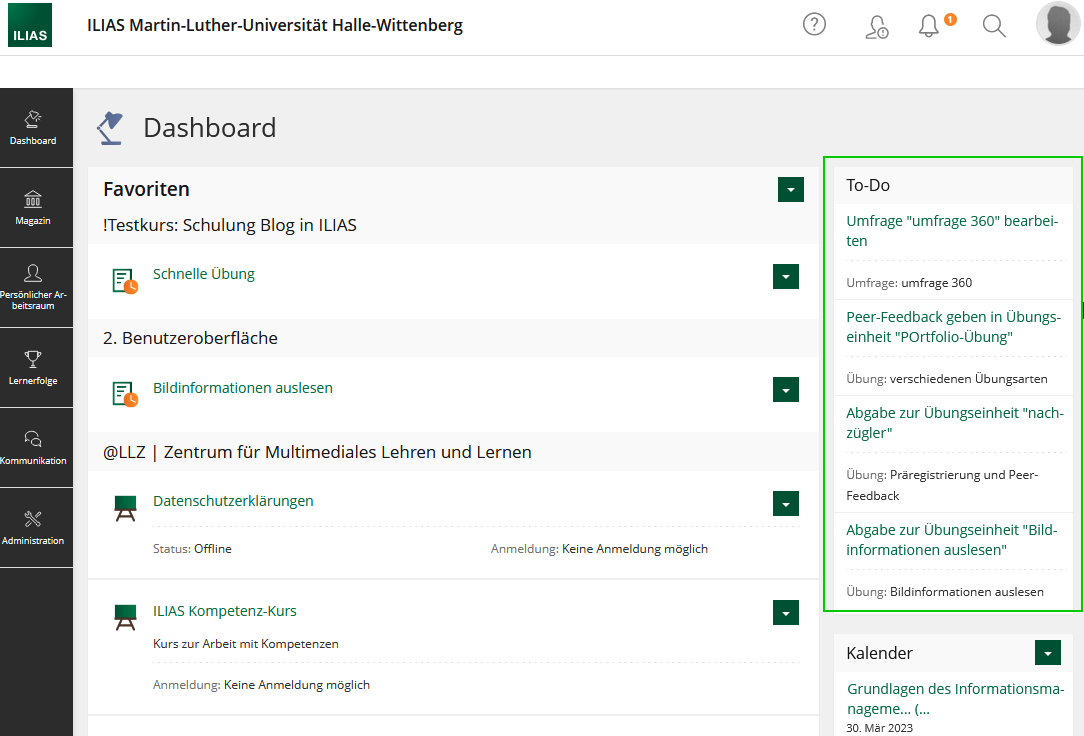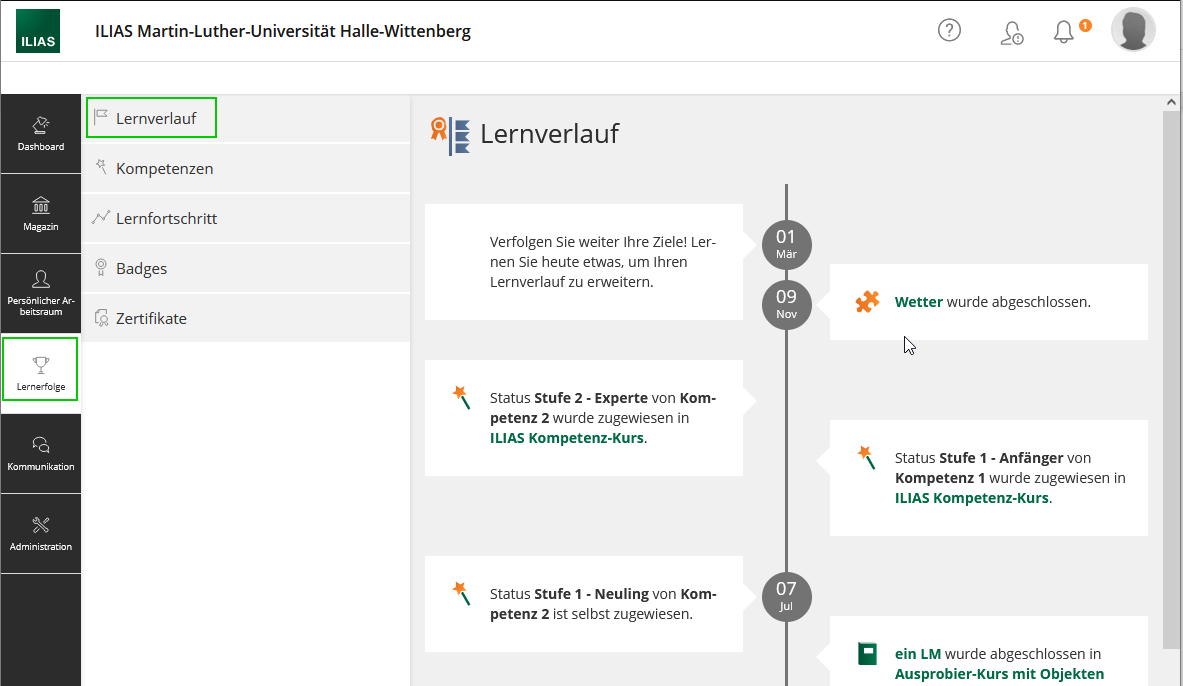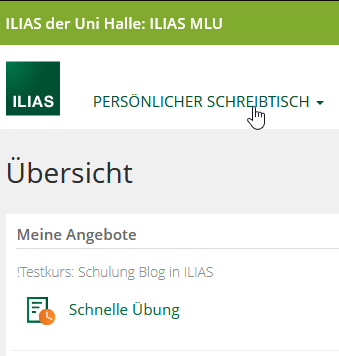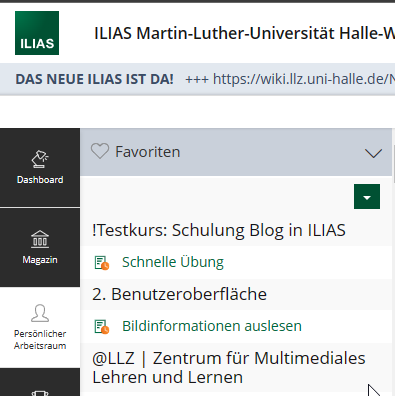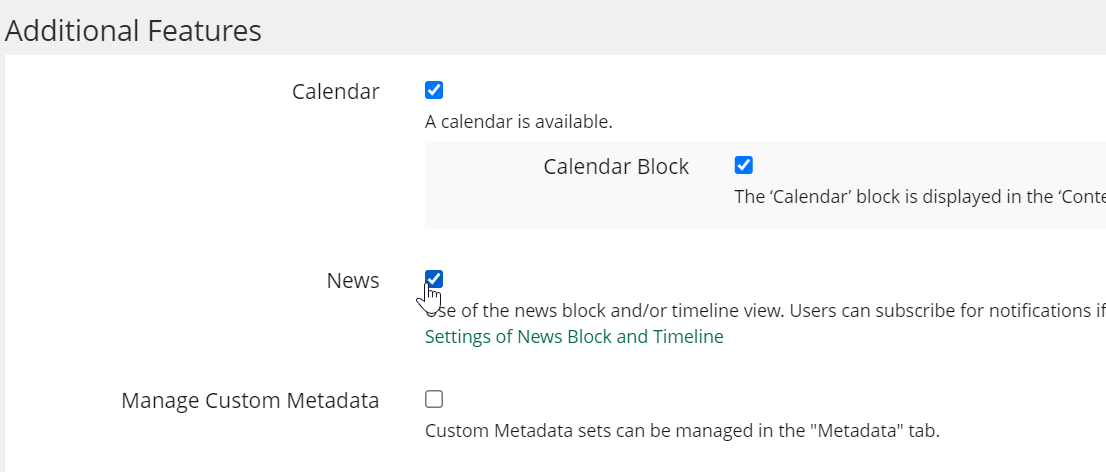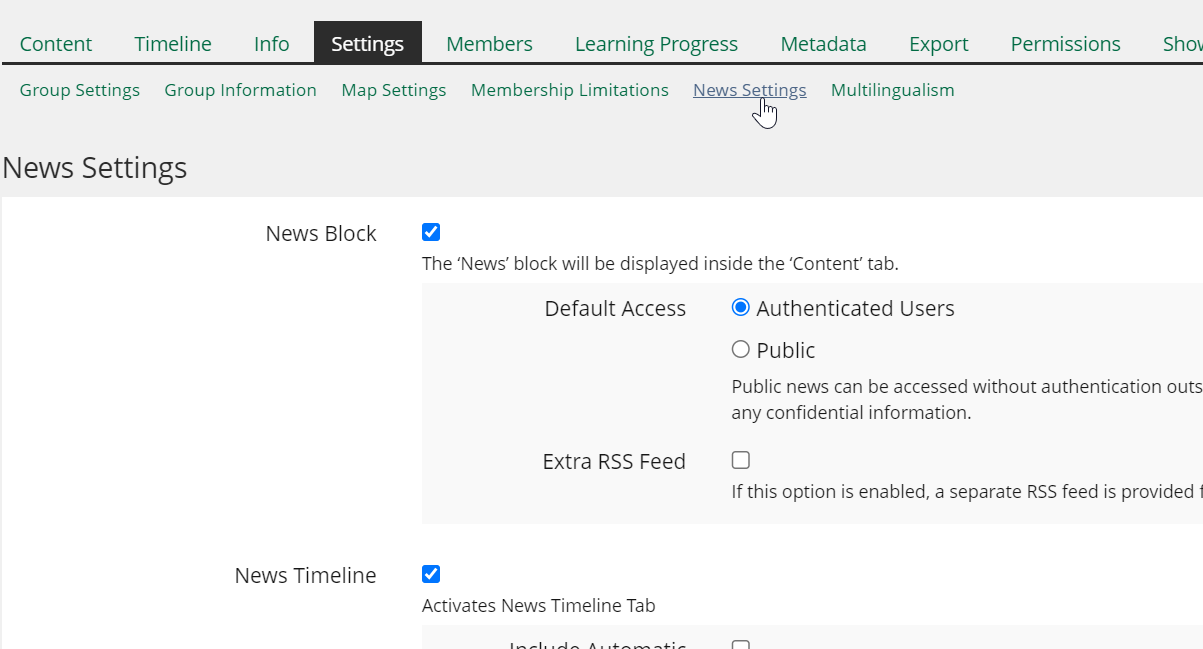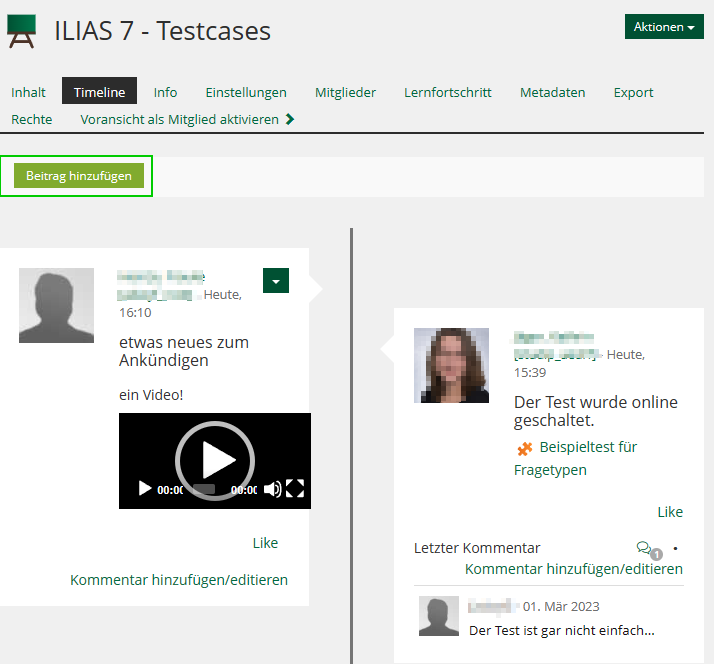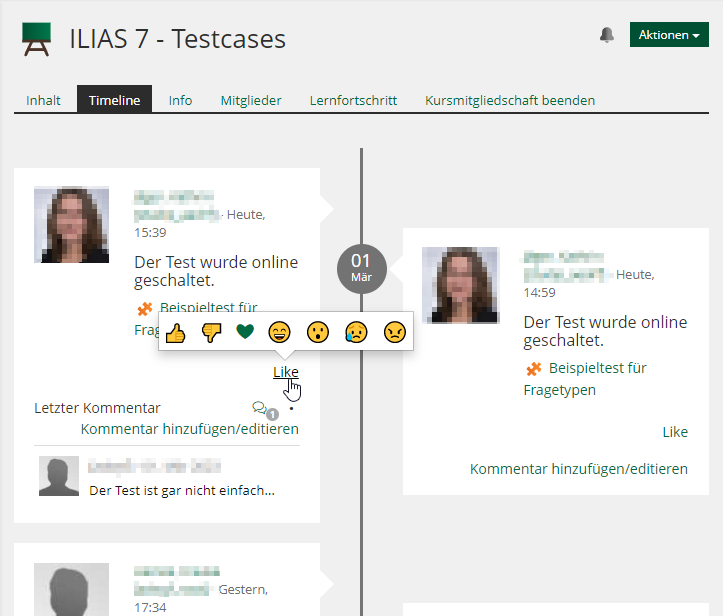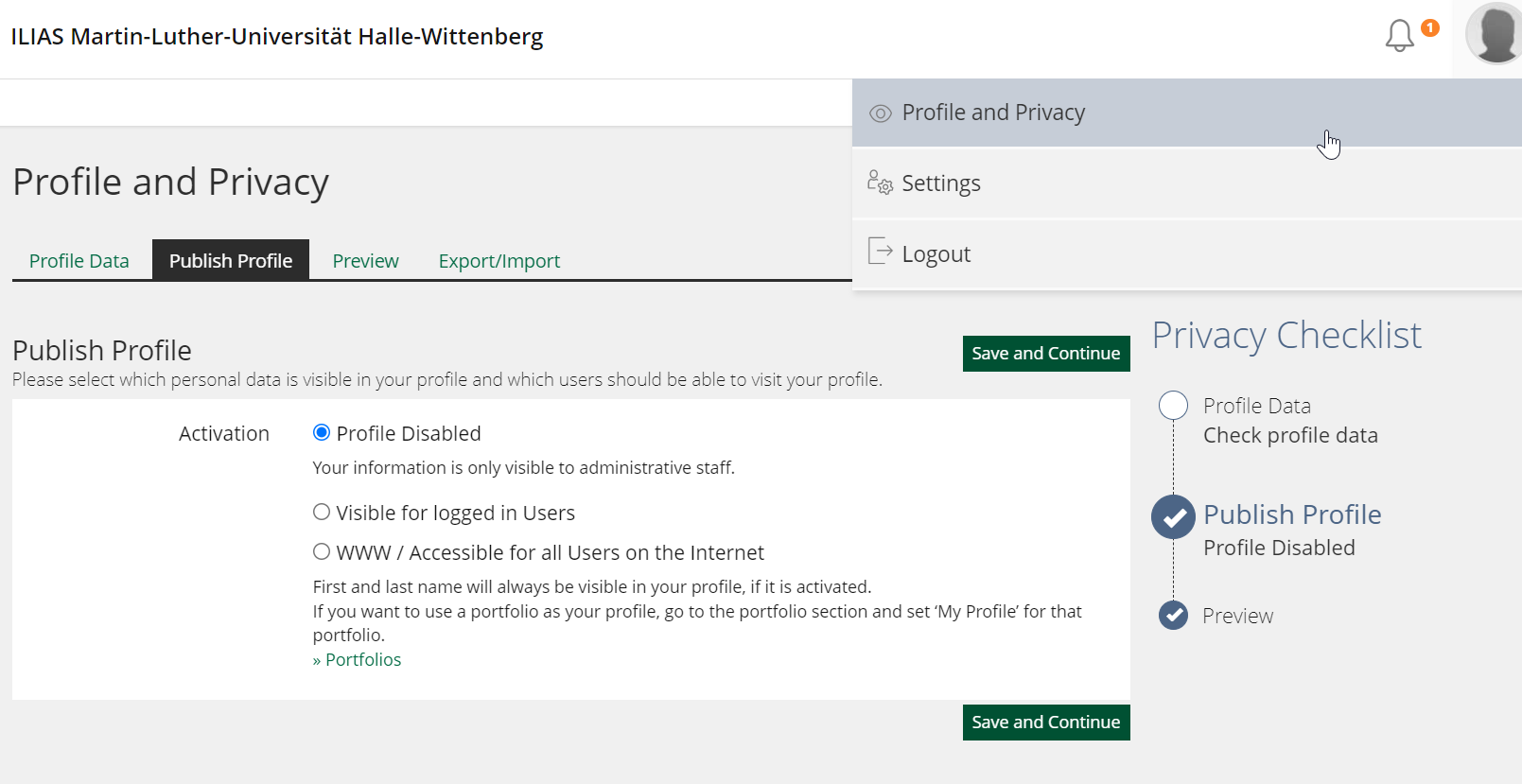Keine Bearbeitungszusammenfassung |
KKeine Bearbeitungszusammenfassung |
||
| Zeile 1: | Zeile 1: | ||
{{ Warnung | | {{ Warnung |If you have any questions or experience issues, please contact [mailto:support@elearning.uni-halle.de support@elearning.uni-halle.de]}} | ||
The | The latest version of ILIAS introduces numerous new features, including significant changes to the site's appearance, menu bar, and editor. | ||
These updates bring ILIAS up to date with modern web design standards, resulting in a more attractive and user-friendly interface that is optimised for mobile devices. | |||
For the official | For the official German manual for ILIAS 7, please visit [https://docu.ilias.de/goto_docu_lm_12040.html offizielle Benutzerdokumentation von ILIAS 7] | ||
The following section presents the most important changes. Additional information can be found by clicking on the corresponding links. | |||
{{Tipp | | {{Tipp | ILIAS has an integrated online assistance feature that correspond with the topic of each site. This means that the explanation provided will fit the site you are currently on. | ||
The online assistance can be accessed by clicking on the question mark symbol [[File:Hilfe sym.png|30px]] located in the top right hand corner of the page. | |||
The question mark symbol [[File:Hilfe sym.png|30px]] | |||
}} | }} | ||
| Zeile 17: | Zeile 16: | ||
{{Vorlage:Häufige Fragen | {{Vorlage:Häufige Fragen | ||
|id=studierende | |id=studierende | ||
|frage= | |frage=What changes are particularly relevant to students? | ||
|antwort= | |antwort= | ||
* a new navigation bar and [[Benutzerführung in ILIAS|user guidance]] | * a new navigation bar and [[Benutzerführung in ILIAS|user guidance]] | ||
| Zeile 24: | Zeile 23: | ||
* [https://wiki.llz.uni-halle.de/Neuerungen_mit_ILIAS_7#NEU:_To-Do-liste Tasks] - all of your tasks at a glance | * [https://wiki.llz.uni-halle.de/Neuerungen_mit_ILIAS_7#NEU:_To-Do-liste Tasks] - all of your tasks at a glance | ||
* [https://wiki.llz.uni-halle.de/Neuerungen_mit_ILIAS_7#Profil Privacy Policy Checklist] for the publication of your profile | * [https://wiki.llz.uni-halle.de/Neuerungen_mit_ILIAS_7#Profil Privacy Policy Checklist] for the publication of your profile | ||
* [[Benutzerführung in ILIAS|Dashboard]] und [https://wiki.llz.uni-halle.de/Neuerungen_mit_ILIAS_7#NEU:_Favoriten Favourites]<br> Please note: The newsfeed on your dashboard will only | * [[Benutzerführung in ILIAS|Dashboard]] und [https://wiki.llz.uni-halle.de/Neuerungen_mit_ILIAS_7#NEU:_Favoriten Favourites]<br> Please note: The newsfeed on your dashboard will only display information for those courses for which the admin has activated the feed. | ||
}} | }} | ||
{{Vorlage:Häufige Fragen | {{Vorlage:Häufige Fragen | ||
|id=wo_Kurse | |id=wo_Kurse | ||
|frage= Where can I | |frage= Where can I access my courses and group memberships?/Where can I find the materials from past semesters? | ||
|antwort=On your dashboard | |antwort=On your dashboard located in the navigation bar on the top left corner, you can access your favourites and „My Courses and Groups“. | ||
Within „My Courses and Groups“ you will find a list of all the courses you are a member of. | |||
To view the last visited sites or an overview of "My Courses and Groups", select the "Repository" option from the menu. | |||
[[File:ILIAS7-Dashboard.png|400px]] [[File:ILIAS7 Magazin-MeineObjekte.png|400px]] | [[File:ILIAS7-Dashboard.png|400px]] [[File:ILIAS7 Magazin-MeineObjekte.png|400px]] | ||
}} | }} | ||
| Zeile 41: | Zeile 40: | ||
|id=wo_eigenedateien | |id=wo_eigenedateien | ||
|frage= Where can I find the MyDocuments folder? (for lecturers only) | |frage= Where can I find the MyDocuments folder? (for lecturers only) | ||
|antwort=Your data files are in the repository under "MLU" inside the folder "user data". | |antwort=Your data files are in the repository under "MLU", inside the folder "user data". | ||
}} | }} | ||
{{Vorlage:Häufige Fragen | {{Vorlage:Häufige Fragen | ||
|id=wo_zuletzt | |id=wo_zuletzt | ||
|frage= Where can I find an overview | |frage= Where can I find an overview of my recently visited items? | ||
|antwort= | |antwort=Under "Repository" in the menu you can view recently visited items. | ||
[[File:ILIAS7 Magazin-zuletztBesucht.png|400px]] | [[File:ILIAS7 Magazin-zuletztBesucht.png|400px]] | ||
}} | }} | ||
| Zeile 53: | Zeile 52: | ||
{{Vorlage:Häufige Fragen | {{Vorlage:Häufige Fragen | ||
|id=schreibtisch | |id=schreibtisch | ||
|frage= Where can I find the items | |frage= Where can I find the items that were on my desk in the previous ILIAS version? | ||
|antwort= Your | |antwort= Your 'Personal Desk' no longer exists. Its items have been centralized in the menu bar.<br> | ||
All of the items | All of the items that were your desk have been included in your [https://wiki.llz.uni-halle.de/Neuerungen_mit_ILIAS_7#NEU:_Favoriten Favourites]. | ||
}} | }} | ||
| Zeile 68: | Zeile 67: | ||
|id=eprüfungen | |id=eprüfungen | ||
|frage=What changes for the online exams? | |frage=What changes for the online exams? | ||
|antwort= | |antwort=Currently, there are no changes for the exams that take place on our seperate exam platform. They will simply be updated to the new ILIAS version in May after all of the current exam period is over. | ||
}} | }} | ||
{{Vorlage:Häufige Fragen | {{Vorlage:Häufige Fragen | ||
|id=login | |id=login | ||
|frage= Does something change | |frage= Does something change with the log in? | ||
|antwort=No. Please log in with your usual login credentials.<br> | |antwort=No. Please log in with your usual login credentials.<br> | ||
The login to Stud.IP has not changed either. | The login to Stud.IP has not changed either. | ||
| Zeile 83: | Zeile 82: | ||
|antwort= A Removal/ Deletion of items is only possible with the multiple selection tool.<br> | |antwort= A Removal/ Deletion of items is only possible with the multiple selection tool.<br> | ||
# Go to "Edit Page". On the left hand site the editor will open up. | # Go to "Edit Page". On the left hand site the editor will open up. | ||
# There, click on "Selection" and | # There, click on "Selection" and select the item you want to remove.<br> '''!''' Alternatively, you can use shift + click on the item to simultaneously switch to the selection tool. | ||
# Click "Delete"/"Cut". A dialogue will open to ask if you are sure you want to delete the selected item. Confirm this. | # Click "Delete"/"Cut". A dialogue will open to ask if you are sure you want to delete the selected item. Confirm this. | ||
# The selected items will be deleted. | # The selected items will be deleted. | ||
| Zeile 94: | Zeile 93: | ||
== Appearance, User Guidance, and Menu Bar == | == Appearance, User Guidance, and Menu Bar == | ||
With the | With the [https://docu.ilias.de/goto_docu_wiki_wpage_5093_1357.html Page Layout Revision], ILIAS has undergone a complete redesign with a focus on mobile usage through the Page Layout Revision.<br> | ||
All items, including course and group content, as well as learning modules, have been visually improved. | |||
The main navigation bar has been | The main navigation bar has been relocated to the left and is now displayed as a vertical bar with tiles. For smaller devices the menu bar is located at the bottom of your display.<br> | ||
Subitems | Subitems are displayed in a second vertical bar called the "Slate". | ||
<gallery perrow="2" heights="300" mode="packed-overlay"> | <gallery perrow="2" heights="300" mode="packed-overlay"> | ||
| Zeile 108: | Zeile 107: | ||
== ILIAS Editor == | == ILIAS Editor == | ||
The ILIAS editor has undergone a fundamental revision to improve user-friendliness. Notably, it now features two modes: editing and selection.<br> | |||
Further innovations are:<br> | Further innovations are:<br> | ||
* Text: the layout of columns | * Text: the layout of columns | ||
| Zeile 119: | Zeile 118: | ||
>> | >> More information on the editor: [[ILIAS-Seiteneditor]] | ||
<gallery perrow="0" heights="300" mode="packed-overlay"> | <gallery perrow="0" heights="300" mode="packed-overlay"> | ||
| Zeile 126: | Zeile 125: | ||
</gallery> | </gallery> | ||
To get an overview | To get an overview of the main features of the new editor you might want to watch the introductory video by databay (currently with German explanations only) on https://youtu.be/HZukWCGj1h4 | ||
== New and Enhanced Objects == | == New and Enhanced Objects == | ||
=== NEW: Content Page === | === NEW: Content Page === | ||
This new | This new feature allows for easy presentation of content such as short incentives, learning motivations, or task information. | ||
A new page | A new page can be generated and configured using the new editor tool, e. g. with texts, videos, pictures etc. Unlike a folder, however, new ILIAS-objects cannot be generated. | ||
{{ Warnung | | {{ Warnung |If a course or group was created before March 2nd, 2023, you cannot add a new 'Content Page' using the 'Add New Item' function. Instead, you must enable the generation of this type of item under the 'Permissions' section of the course or group. To do this, go to the main page of the course or group and click on 'Permissions'. Then, go to the 'Create New Objects' section for the specific role (course administrator or course tutor) and select 'Content Page'. Finally, save your settings.}} | ||
=== NEW: Learning Sequence === | === NEW: Learning Sequence === | ||
The learning sequence is a new tool with great potential. It allows for the assembly of different elements, such as content pages, tests, learning modules, files, and surveys, in a specific order. The students are presented with a reduced and clear structure, enabling them to efficiently work through the content. The learning sequence can also be complemented with introductory and concluding pages. | |||
To view the contents and order of the learning sequence, to to "Content" >> "View Content" within the learning sequence. To exit the learning sequence, click on the 'x' at the top right corner. | |||
<gallery perrow="0" heights="300" mode="packed-overlay"> | <gallery perrow="0" heights="300" mode="packed-overlay"> | ||
| Zeile 144: | Zeile 143: | ||
</gallery> | </gallery> | ||
Previously, achieving these learning objectives required extensive and complex configuration of the course page or the use of a separate learning module. Even then, it was not possible to combine them with other ILIAS items. | |||
However, each learning sequence now comes with its own membership management, allowing it to be used outside of courses or groups. | |||
| Zeile 154: | Zeile 153: | ||
</gallery> | </gallery> | ||
{{ Warnung | | {{ Warnung |If a course or group was created before March 2nd, 2023, you cannot add a new 'Content Page' using the 'Add New Item' function. Instead, you must enable the generation of this type of item under the 'Permissions' section of the course or group. To do this, go to the main page of the course or group and click on 'Permissions'. Then, go to the 'Create New Objects' section for the specific role (course administrator or course tutor) and select 'Content Page'. Finally, save your settings.}} | ||
=== NEW: MLUconf/Webex Meeting === | === NEW: MLUconf/Webex Meeting === | ||
Creating an MLUconf/Webex meeting is not a new feature, but the approach and item type are. | |||
The 'MLUconf/Webex Meeting' option allows you to establish a digital conference room for MLUconf or Webex in courses and groups. | |||
Therefore, you can now choose between three kinds of conference rooms within courses or groups: | Therefore, you can now choose between three kinds of conference rooms within courses or groups: | ||
| Zeile 170: | Zeile 169: | ||
</gallery> | </gallery> | ||
{{ Warnung | | {{ Warnung |If a course or group was created before March 2nd, 2023, you cannot add a new 'Content Page' using the 'Add New Item' function. Instead, you must enable the generation of this type of item under the 'Permissions' section of the course or group. To do this, go to the main page of the course or group and click on 'Permissions'. Then, go to the 'Create New Objects' section for the specific role (course administrator or course tutor) and select 'Content Page'. Finally, save your settings.}} | ||
=== Booking Pool === | === Booking Pool === | ||
| Zeile 176: | Zeile 175: | ||
'''New booking type “No Schedule, Using Preferences”'''<br> | '''New booking type “No Schedule, Using Preferences”'''<br> | ||
In addition to “Fixed Schedule” (e. g. suitable for rooms or technics) and “No Schedule, Direct Booking” (e.g. suitable for presentation topics) there now is a third booking type: "No Schedule, Using Preferences"<br> | In addition to “Fixed Schedule” (e. g. suitable for rooms or technics) and “No Schedule, Direct Booking” (e.g. suitable for presentation topics) there now is a third booking type: "No Schedule, Using Preferences"<br> | ||
This type enables | This type enables participants to state their preferences. After a set deadline, those preferences will be automatically converted into fixed bookings. The number of possible preferences per user can be set/adjusted. | ||
'''New tab “Participants”, Assigning Bookings to Participants'''<br> | '''New tab “Participants”, Assigning Bookings to Participants'''<br> | ||
By clicking on the "Add Users of Current Course" button, participants of that course/groups can be transferred to the new overview of participants within the booking pool. This provides course admins with a complete overview of all placed bookings and users. In this section, bookings can also be assigned to participants or cancelled if neccessary. | |||
'''Notifications for Booked Schedules'''<br> | '''Notifications for Booked Schedules'''<br> | ||
Under 'Fixed Schedule', course administrators can set reminders for booked schedules. This will automatically send a notification email to participants to remind them of their schedule. | |||
| Zeile 196: | Zeile 195: | ||
=== NEW: Task List === | === NEW: Task List === | ||
Under | Under the 'Dashboard' section, you can now find a task section. <br> | ||
This section contains all pending tasks, such as exercises, surveys, drafts for blogs or forum posts, that are automatically generated for each individual user. All pending tasks are linked to the corresponding ILIAS item, allowing users to easily maintain an overview of the tasks they need to attend to. | |||
<gallery perrow="1" heights="300" mode="packed-overlay"> | <gallery perrow="1" heights="300" mode="packed-overlay"> | ||
| Zeile 207: | Zeile 205: | ||
There is a bell on the top header.[[Datei:Glocksymbol.png|30px]]<br> | There is a bell on the top header.[[Datei:Glocksymbol.png|30px]]<br> | ||
Here you can find the | Here you can find the "News Office" of ILIAS. Different kinds of notifications are collected for each user: | ||
* Background task - e.g. the compiling of large download packages | * Background task - e.g. the compiling of large download packages | ||
| Zeile 216: | Zeile 214: | ||
=== NEW: Learning History === | === NEW: Learning History === | ||
The learning history | The learning history shows a timeline of personal learning achievements, including learning progress, skills, badges, and certificates. It is automatically generated for each user.<br> | ||
Users can view their learning history with the menu under "Achievements" > slate: "Learning History". | Users can view their learning history with the menu under "Achievements" > slate: "Learning History". | ||
| Zeile 224: | Zeile 222: | ||
=== NEW: Favourites === | === NEW: Favourites === | ||
Favourites | Favourites allow users to easily access important, interesting, or frequently used items. This feature is not new, but has been renamed from its previous title "Put on Your Desk" in the old ILIAS version. | ||
Users must manually select their own favourites, so new courses and groups will not automatically appear under 'Favourites'. <br> | |||
With the transition to the new ILIAS version, all the content from the desk has been transferred to the favourites. | With the transition to the new ILIAS version, all the content from the desk has been transferred to the favourites. | ||
| Zeile 267: | Zeile 265: | ||
The timeline of the new ILIAS version is now more interactive and dynamic.<br> | The timeline of the new ILIAS version is now more interactive and dynamic.<br> | ||
Course administrators can | Course administrators can post pictures, videos, etc., under the control "Add News". Members can then add comments or reactions such as likes or emojis. On request, each member can receive notifications about new posts via e-mail. | ||
>How do I active the timeline/news for courses and groups?<br> | >How do I active the timeline/news for courses and groups?<br> | ||
Version vom 6. April 2024, 13:33 Uhr
| If you have any questions or experience issues, please contact support@elearning.uni-halle.de |
The latest version of ILIAS introduces numerous new features, including significant changes to the site's appearance, menu bar, and editor. These updates bring ILIAS up to date with modern web design standards, resulting in a more attractive and user-friendly interface that is optimised for mobile devices.
For the official German manual for ILIAS 7, please visit offizielle Benutzerdokumentation von ILIAS 7
The following section presents the most important changes. Additional information can be found by clicking on the corresponding links.
FAQ to the New Update
- a new navigation bar and user guidance
- a new and improved mobile display to enable the use of ILIAS on the way
- learning success - the learning success for each course in one place
- Tasks - all of your tasks at a glance
- Privacy Policy Checklist for the publication of your profile
- Dashboard und Favourites
Please note: The newsfeed on your dashboard will only display information for those courses for which the admin has activated the feed.
On your dashboard located in the navigation bar on the top left corner, you can access your favourites and „My Courses and Groups“.
Within „My Courses and Groups“ you will find a list of all the courses you are a member of.
To view the last visited sites or an overview of "My Courses and Groups", select the "Repository" option from the menu.
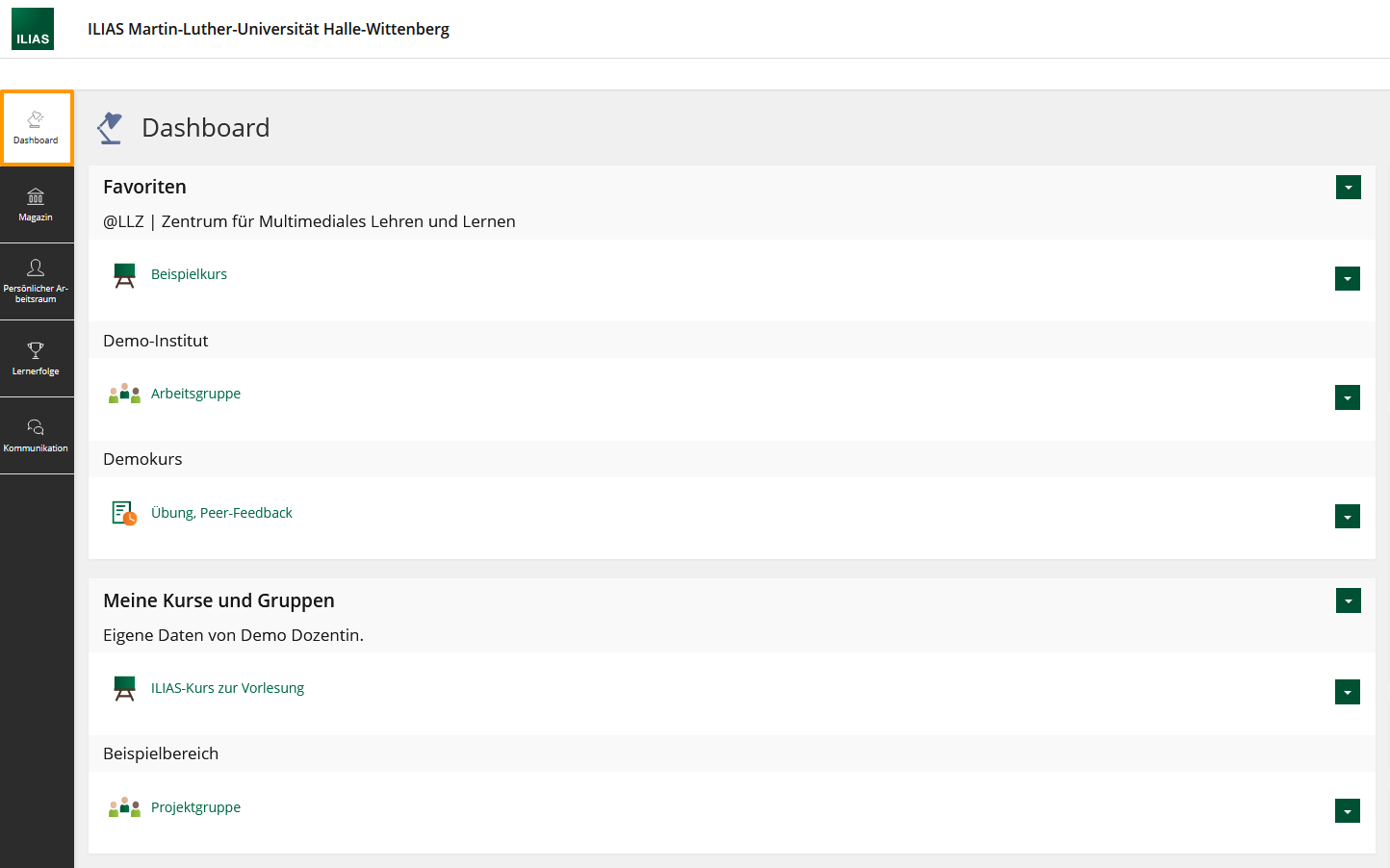
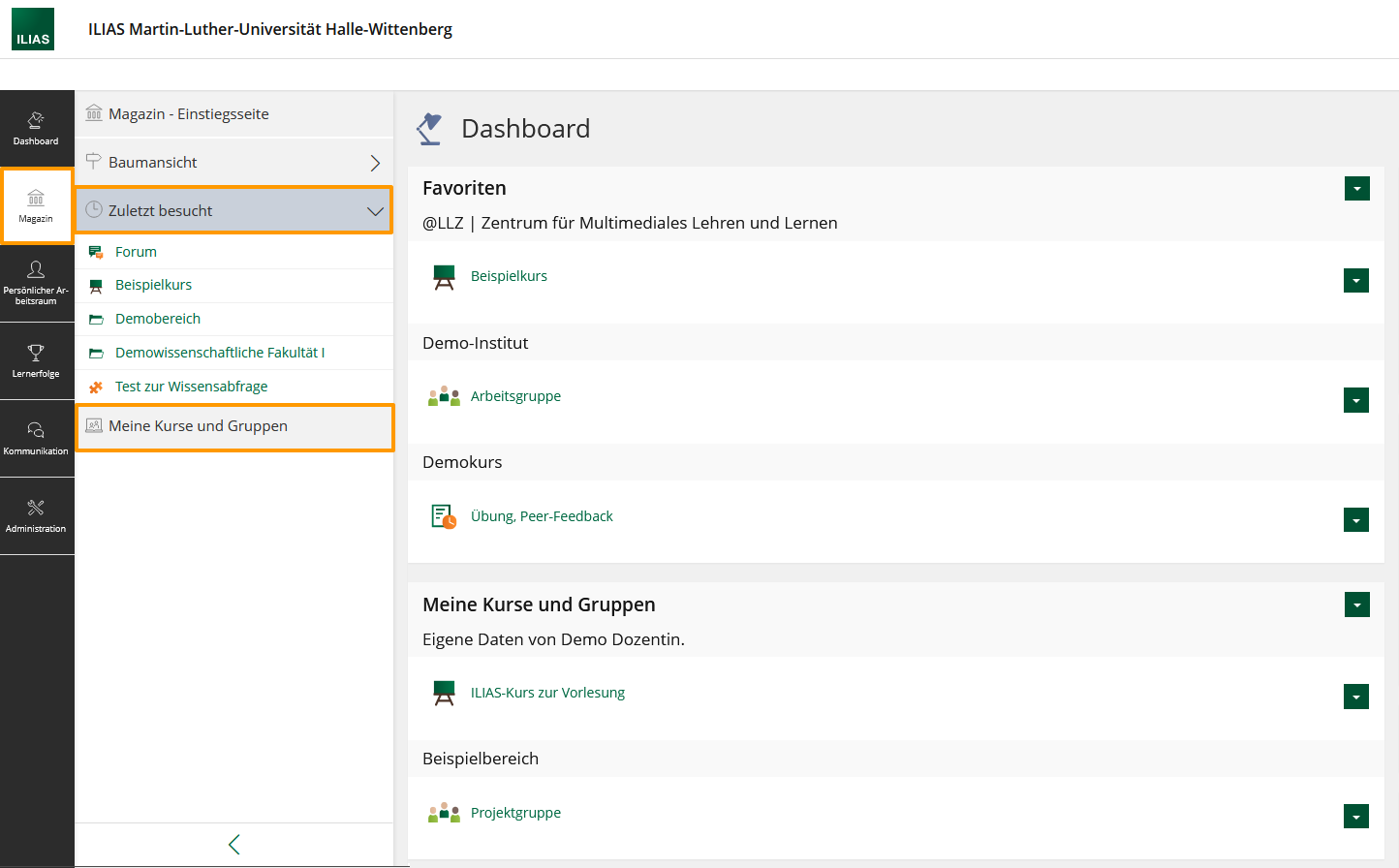
Your 'Personal Desk' no longer exists. Its items have been centralized in the menu bar.
No, all features and permissions stay the same.
No. Please log in with your usual login credentials.
A Removal/ Deletion of items is only possible with the multiple selection tool.
- Go to "Edit Page". On the left hand site the editor will open up.
- There, click on "Selection" and select the item you want to remove.
! Alternatively, you can use shift + click on the item to simultaneously switch to the selection tool. - Click "Delete"/"Cut". A dialogue will open to ask if you are sure you want to delete the selected item. Confirm this.
- The selected items will be deleted.
Appearance, User Guidance, and Menu Bar
With the Page Layout Revision, ILIAS has undergone a complete redesign with a focus on mobile usage through the Page Layout Revision.
All items, including course and group content, as well as learning modules, have been visually improved.
The main navigation bar has been relocated to the left and is now displayed as a vertical bar with tiles. For smaller devices the menu bar is located at the bottom of your display.
Subitems are displayed in a second vertical bar called the "Slate".
ILIAS Editor
The ILIAS editor has undergone a fundamental revision to improve user-friendliness. Notably, it now features two modes: editing and selection.
Further innovations are:
- Text: the layout of columns
- Text: autosave
- Text: Enter generates a new paragraph
- Text: assign the same format (e.g. a title) for multiple items simultaneously
- Drag and drop of items
- multiple selection of items and actions
- New feature: "Insert External Content" (add an Opencast recording)
>> More information on the editor: ILIAS-Seiteneditor
To get an overview of the main features of the new editor you might want to watch the introductory video by databay (currently with German explanations only) on https://youtu.be/HZukWCGj1h4
New and Enhanced Objects
NEW: Content Page
This new feature allows for easy presentation of content such as short incentives, learning motivations, or task information. A new page can be generated and configured using the new editor tool, e. g. with texts, videos, pictures etc. Unlike a folder, however, new ILIAS-objects cannot be generated.
NEW: Learning Sequence
The learning sequence is a new tool with great potential. It allows for the assembly of different elements, such as content pages, tests, learning modules, files, and surveys, in a specific order. The students are presented with a reduced and clear structure, enabling them to efficiently work through the content. The learning sequence can also be complemented with introductory and concluding pages.
To view the contents and order of the learning sequence, to to "Content" >> "View Content" within the learning sequence. To exit the learning sequence, click on the 'x' at the top right corner.
Previously, achieving these learning objectives required extensive and complex configuration of the course page or the use of a separate learning module. Even then, it was not possible to combine them with other ILIAS items.
However, each learning sequence now comes with its own membership management, allowing it to be used outside of courses or groups.
NEW: MLUconf/Webex Meeting
Creating an MLUconf/Webex meeting is not a new feature, but the approach and item type are. The 'MLUconf/Webex Meeting' option allows you to establish a digital conference room for MLUconf or Webex in courses and groups.
Therefore, you can now choose between three kinds of conference rooms within courses or groups:
- MLUconf
- Adobe Connect
- Webex >> Currently unavailable! We are working on a solution.
Booking Pool
New booking type “No Schedule, Using Preferences”
In addition to “Fixed Schedule” (e. g. suitable for rooms or technics) and “No Schedule, Direct Booking” (e.g. suitable for presentation topics) there now is a third booking type: "No Schedule, Using Preferences"
This type enables participants to state their preferences. After a set deadline, those preferences will be automatically converted into fixed bookings. The number of possible preferences per user can be set/adjusted.
New tab “Participants”, Assigning Bookings to Participants
By clicking on the "Add Users of Current Course" button, participants of that course/groups can be transferred to the new overview of participants within the booking pool. This provides course admins with a complete overview of all placed bookings and users. In this section, bookings can also be assigned to participants or cancelled if neccessary.
Notifications for Booked Schedules
Under 'Fixed Schedule', course administrators can set reminders for booked schedules. This will automatically send a notification email to participants to remind them of their schedule.
New and Enhanced System Functions
NEW: Task List
Under the 'Dashboard' section, you can now find a task section.
This section contains all pending tasks, such as exercises, surveys, drafts for blogs or forum posts, that are automatically generated for each individual user. All pending tasks are linked to the corresponding ILIAS item, allowing users to easily maintain an overview of the tasks they need to attend to.
NEW: News Office
There is a bell on the top header.![]()
Here you can find the "News Office" of ILIAS. Different kinds of notifications are collected for each user:
- Background task - e.g. the compiling of large download packages
- Mails/Messages
- Contact requests
- new certificates
NEW: Learning History
The learning history shows a timeline of personal learning achievements, including learning progress, skills, badges, and certificates. It is automatically generated for each user.
Users can view their learning history with the menu under "Achievements" > slate: "Learning History".
NEW: Favourites
Favourites allow users to easily access important, interesting, or frequently used items. This feature is not new, but has been renamed from its previous title "Put on Your Desk" in the old ILIAS version.
Users must manually select their own favourites, so new courses and groups will not automatically appear under 'Favourites'.
With the transition to the new ILIAS version, all the content from the desk has been transferred to the favourites.
You can find your favourites
- on the Dashboard at the topmost section
- in your Personal Workspace > Favourites
Favourites can be individually configured and sorted according to type or place. Deleting entries is possible as well.
How can I label something as a favourite?
- Go to the according object
- Click on the "Actions" button in the top right corner
- Click on "Add to Favourites"
License Administration
You can assign a creative common license to your ILIAS items. The material will be then labelled as Open Educational Ressource (OER).
The legal and organizational conditions for the OER material are currently worked on at the MLU. We will pass on any information as soon as there are updates.
Of course, you can label your ILIAS material with a free license already:
- Go to the object you want to label
- Go to the menu and click on "Metadata"
- Under the section "Copyright", select a fitting Creative-Commons-Lizenz and fill in the necessary information regarding the author etc. Save your settings.
- The license is now accessible in the information tab of your item.
Timeline
The timeline of the new ILIAS version is now more interactive and dynamic.
Course administrators can post pictures, videos, etc., under the control "Add News". Members can then add comments or reactions such as likes or emojis. On request, each member can receive notifications about new posts via e-mail.
>How do I active the timeline/news for courses and groups?
- Go to "Settings" in the course/group
- In the section "Additional Features", tick the box next to "News".
- In the settings, you can now see a tab "News Settings"
- There, you can add a news block, a timeline, and notfications. Save your settings.
After the timeline was added, all the members of the course/group have access to the tab "Timeline".
Profile
Users can now choose more easily which data will be accessible for others in their personal profile. The individual steps of publication are listen in the "Privacy Checklist" under "Profile and Privacy".
Innovation Assessment (Tests, Question Pool Tests and Exercises)
The general appearance and usage of the test and assessment section has basically stayed the same and the transition should not prove difficult. The changes made only concern details of the tests, question pool test, and exercises, and aim to make the usage of these items clearer and more intuitive. A few options are now at a different place, mostly in the more lucid submenu. Below, you can find a summary of the most important extensions. This will be regularly augmented until the exam platform has been updated in May.
Questions and Question Pool Tests
- For the questions, the information "Lifecycle" has been added. With this, the questions can be tagged with additional information such as "draft" or "outdated". This can be used as a filter as well.
- You can now add comments to questions, which might be useful if multiple persons are creating a test together.
- In the preview the question are now displayed exactly how they will appear in an exam.
- The scored number of points can directly be queried while testing the created questions.
Tests
- The tab "Members" can now be found under "Dashboard". Here, all the administrative procedures take place during an exam.
- Additionally, there is now a tab called "Results". Depending on the permissions and privacy settings, the results of the exam are displayed in this section.
- Changes have been made regarding the manually checked grading. Here, you can now give detailed feedback and label your grading as final or in need of further grading processes.
- Re-correction of questions can now be made without an additional overlay. Under a new tab called "Statistics", points and possible answers can be corrected and saved.
Exercises
- Improved control over the submission period
- A release of key solutions at a set date
- Random assigment of exercises
- Reminders to hand in task at a set date
Things that are not included anymore in ILIAS 7
The item "Place of Learning" does not exist anymore. Aready created items like this cannot be used anymore and can be deleted.
The Internet Explorer is an outdated browser that is not updated anymore. Its successor is Microsoft Edge.
Ilias does not support the Internet Explorer any longer, meaning that if you are using Internet Explorer you will not be able to log into ILIAS. Please switch to an up-to-date browser such as Firefox, Chrome, Safari, Opera, or Edge.